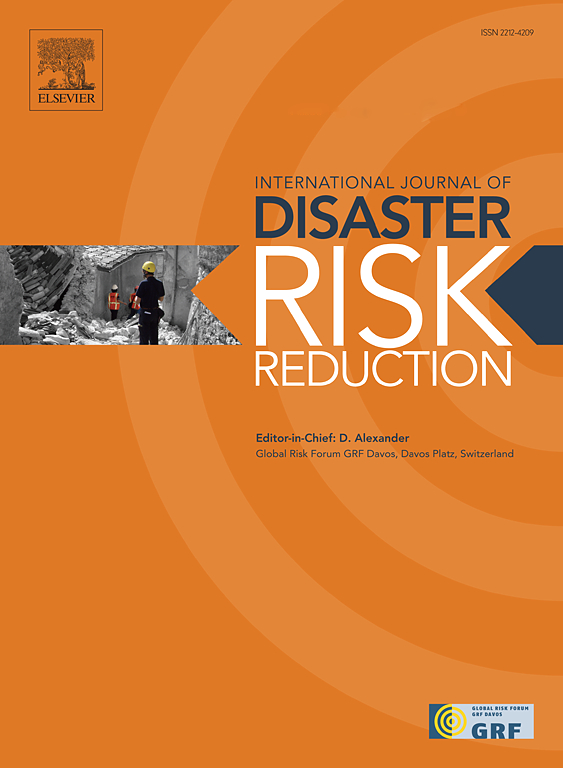Rethinking the agricultural use of fire and its influence on the occurrence of wildfire in high Andean communities of Cusco, Peru
IF 4.5
1区 地球科学
Q1 GEOSCIENCES, MULTIDISCIPLINARY
International journal of disaster risk reduction
Pub Date : 2025-07-14
DOI:10.1016/j.ijdrr.2025.105702
引用次数: 0
Abstract
The use of fire in agriculture has been a fundamental practice since early human societies, playing a key role in land preparation, weed control, and soil fertility management. In the Peruvian Andes, fire remains widely employed by rural communities, despite strict legal prohibitions aimed at reducing wildfire occurrence. However, statistical evidence demonstrates that these punitive policies have failed to curb wildfires, which have instead increased in frequency. This study critically examines the agricultural use of fire in high Andean communities of Cusco, Peru, exploring its socio-cultural, economic, and environmental dimensions.
Through ethnographic research and qualitative methodologies, the study identifies the motivations behind fire use, traditional fire-management practices, local and institutional perceptions, and community responses to wildfires. Findings reveal that fire is an indispensable agricultural tool, deeply embedded in rural livelihoods. The study also highlights the inadequacy of current fire management policies, which rely primarily on prohibition and emergency response without offering viable alternatives for smallholder farmers.
To address this gap, the study proposes a paradigm shift in fire governance, advocating for a more inclusive and sustainable approach. Key recommendations include integrating prescribed burning, implementing incentive-based compensation schemes, and strengthening local governance structures. Additionally, the study underscores the necessity of qualitative research in informing quantitative analyses of wildfire occurrence, ensuring that policy interventions are grounded in local realities. Ultimately, rethinking the agricultural use of fire is not only an environmental concern but also a social and economic imperative for high Andean communities.
重新思考火的农业利用及其对秘鲁库斯科安第斯高山社区野火发生的影响
自早期人类社会以来,在农业中使用火一直是一种基本做法,在土地准备、杂草控制和土壤肥力管理方面发挥着关键作用。在秘鲁的安第斯山脉,尽管有严格的法律禁止减少野火的发生,但农村社区仍然广泛使用火。然而,统计证据表明,这些惩罚性政策未能遏制野火,反而增加了频率。本研究批判性地考察了秘鲁库斯科安第斯山脉高社区的农业用火,探索其社会文化、经济和环境维度。通过民族志研究和定性方法,该研究确定了火使用背后的动机、传统的火灾管理实践、地方和机构的观念以及社区对野火的反应。调查结果表明,火是一种不可或缺的农业工具,深深植根于农村生计。该研究还强调了当前火灾管理政策的不足之处,这些政策主要依赖于禁止和应急反应,而没有为小农提供可行的替代方案。为了解决这一差距,该研究提出了火灾治理的范式转变,倡导采用更具包容性和可持续性的方法。主要建议包括整合规定焚烧、实施基于激励的补偿方案以及加强地方治理结构。此外,该研究强调了定性研究为野火发生的定量分析提供信息的必要性,确保政策干预以当地实际为基础。最终,重新思考火的农业用途不仅是一个环境问题,也是安第斯高原社区的社会和经济需要。
本文章由计算机程序翻译,如有差异,请以英文原文为准。
求助全文
约1分钟内获得全文
求助全文
来源期刊

International journal of disaster risk reduction
GEOSCIENCES, MULTIDISCIPLINARYMETEOROLOGY-METEOROLOGY & ATMOSPHERIC SCIENCES
CiteScore
8.70
自引率
18.00%
发文量
688
审稿时长
79 days
期刊介绍:
The International Journal of Disaster Risk Reduction (IJDRR) is the journal for researchers, policymakers and practitioners across diverse disciplines: earth sciences and their implications; environmental sciences; engineering; urban studies; geography; and the social sciences. IJDRR publishes fundamental and applied research, critical reviews, policy papers and case studies with a particular focus on multi-disciplinary research that aims to reduce the impact of natural, technological, social and intentional disasters. IJDRR stimulates exchange of ideas and knowledge transfer on disaster research, mitigation, adaptation, prevention and risk reduction at all geographical scales: local, national and international.
Key topics:-
-multifaceted disaster and cascading disasters
-the development of disaster risk reduction strategies and techniques
-discussion and development of effective warning and educational systems for risk management at all levels
-disasters associated with climate change
-vulnerability analysis and vulnerability trends
-emerging risks
-resilience against disasters.
The journal particularly encourages papers that approach risk from a multi-disciplinary perspective.
 求助内容:
求助内容: 应助结果提醒方式:
应助结果提醒方式:


